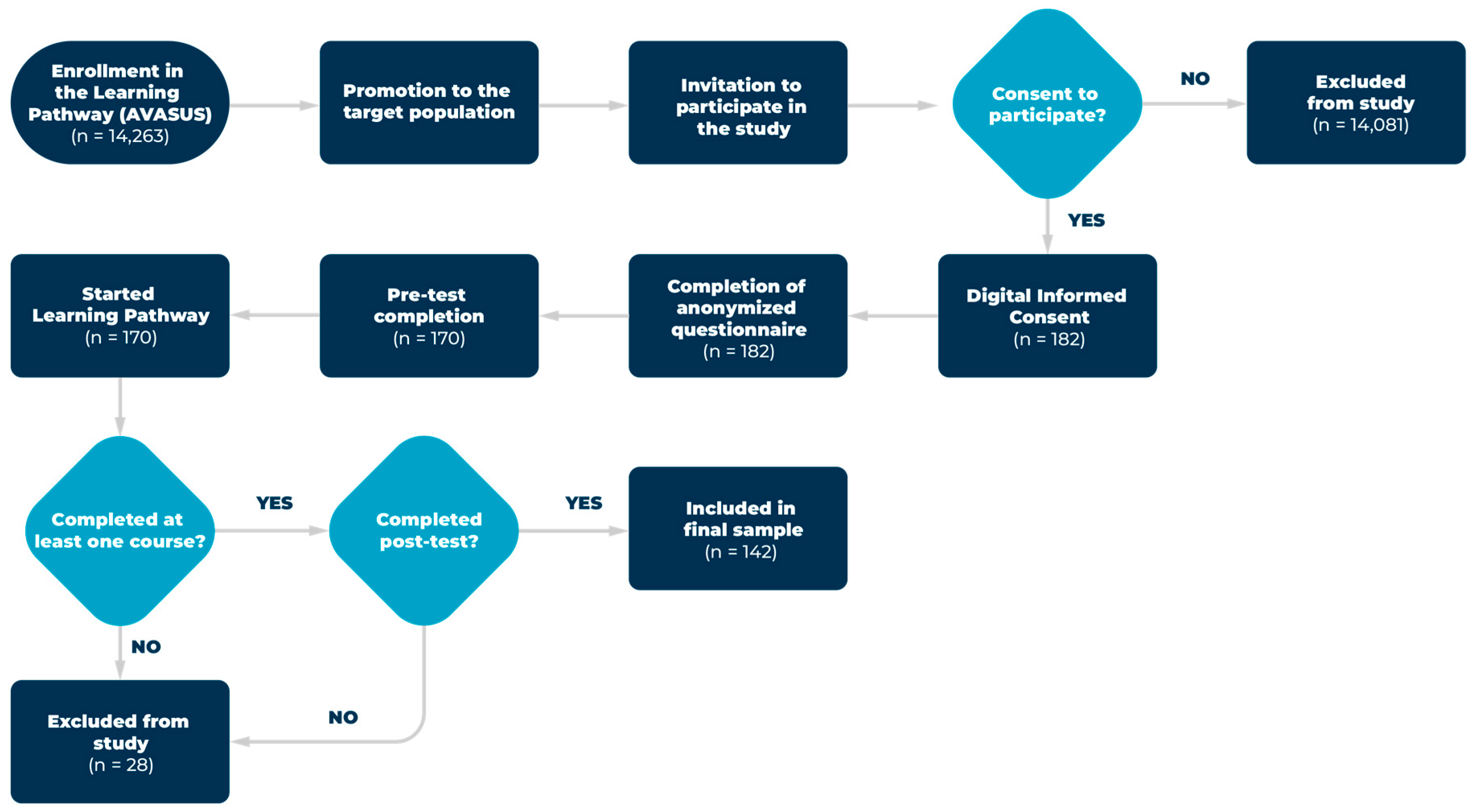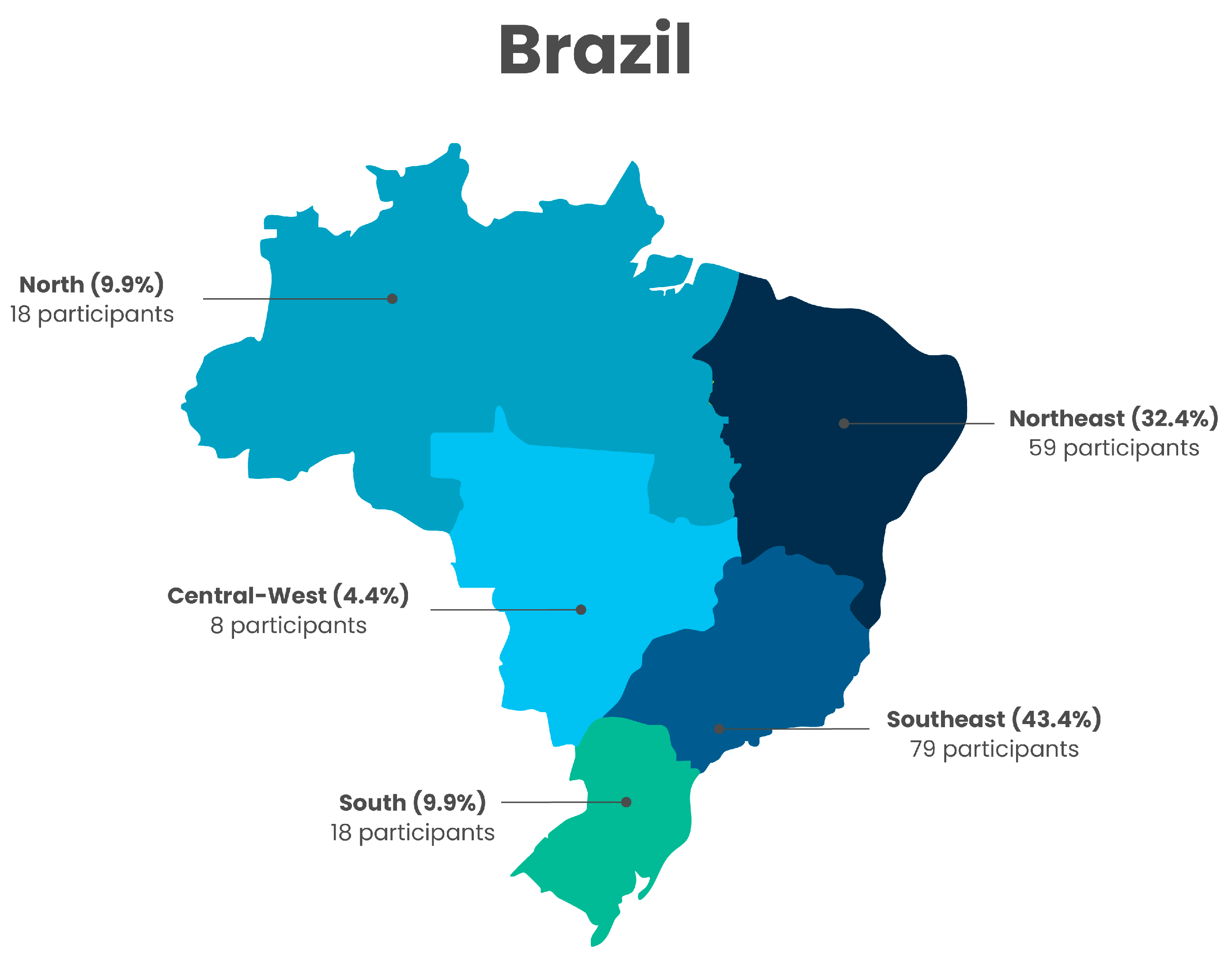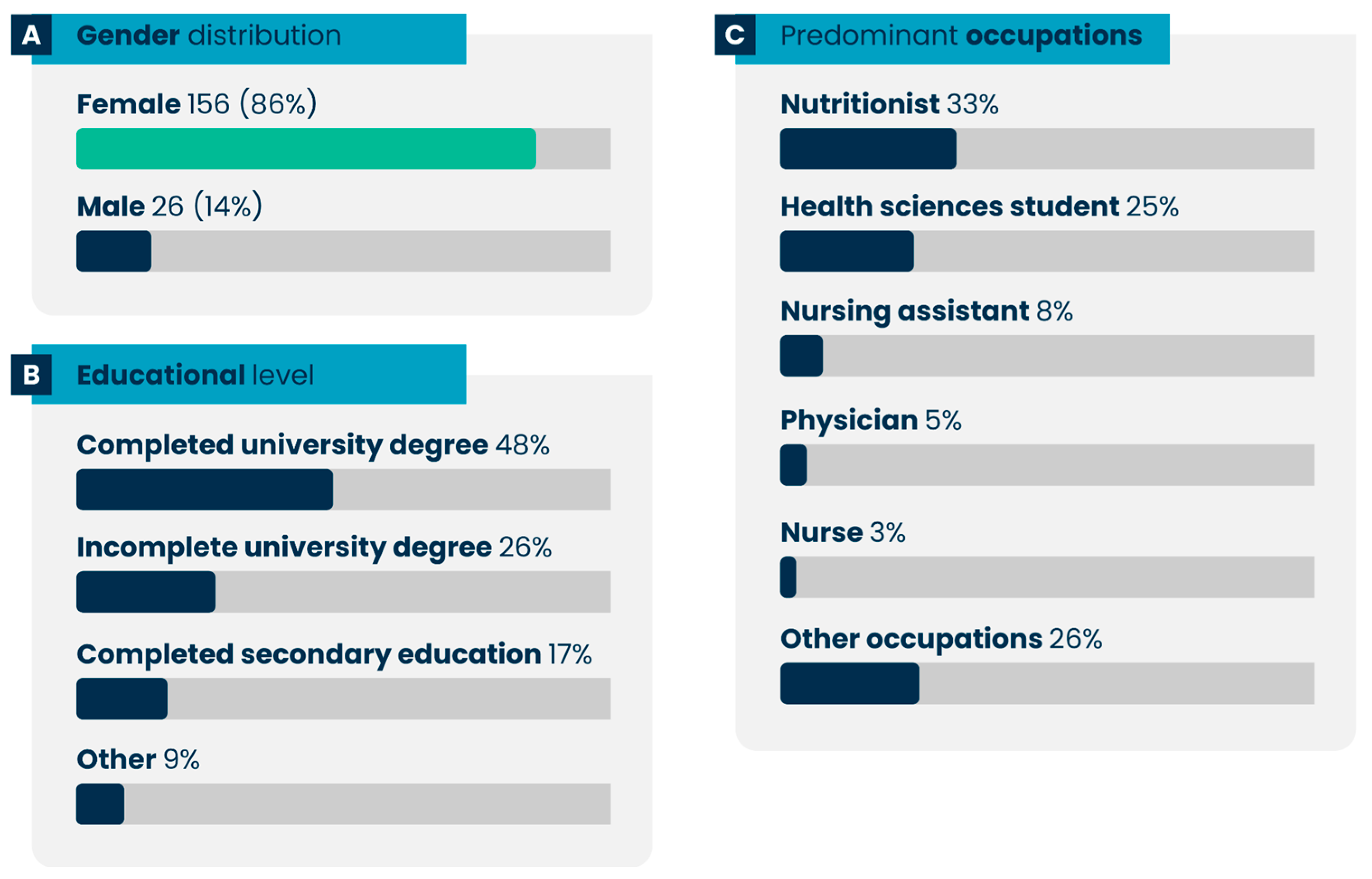Effectiveness of a Learning Pathway on Food and Nutrition in Amyotrophic Lateral Sclerosis
Abstract
1. Introduction
2. Materials and Methods
2.1. Ethical and Legal Aspects
2.2. Study Design and Population
2.3. Educational Intervention
2.4. Evaluation of Learning Outcomes
2.5. Data Collection
2.6. Data Processing
2.7. Data Analysis
3. Results
3.1. Sociodemographic and Professional Characteristics of Participants
3.2. Educational Intervention of the Learning Pathway
4. Discussion
5. Conclusions
Author Contributions
Funding
Institutional Review Board Statement
Informed Consent Statement
Data Availability Statement
Acknowledgments
Conflicts of Interest
References
- Ludolph, A.; Dupuis, L.; Kasarskis, E.; Steyn, F.; Ngo, S.; McDermott, C. Nutritional and Metabolic Factors in Amyotrophic Lateral Sclerosis. Nat. Rev. Neurol. 2023, 19, 511–524. [Google Scholar] [CrossRef] [PubMed]
- Castro-Rodríguez, E.; Azagra, R.; Gómez-Batiste, X.; Povedano, M. La Esclerosis Lateral Amiotrófica (ELA) Desde La Atención Primaria. Epidemiología y Características Clínico-Asistenciales. Atención Primaria 2021, 53, 102158. [Google Scholar] [CrossRef]
- Feldman, E.L.; Goutman, S.A.; Petri, S.; Mazzini, L.; Savelieff, M.G.; Shaw, P.J.; Sobue, G. Amyotrophic Lateral Sclerosis. Lancet 2022, 400, 1363–1380. [Google Scholar] [CrossRef]
- Goutman, S.A.; Hardiman, O.; Al-Chalabi, A.; Chió, A.; Savelieff, M.G.; Kiernan, M.C.; Feldman, E.L. Emerging Insights into the Complex Genetics and Pathophysiology of Amyotrophic Lateral Sclerosis. Lancet Neurol. 2022, 21, 465–479. [Google Scholar] [CrossRef]
- López-Gómez, J.J.; Ballesteros-Pomar, M.D.; Torres-Torres, B.; la Maza, B.P.D.; Penacho-Lázaro, M.Á.; Palacio-Mures, J.M.; Abreu-Padín, C.; López-Guzmán, A.; Luis-Román, D.A.D. Malnutrition at Diagnosis in Amyotrophic Lateral Sclerosis (Als) and Its Influence on Survival: Using Glim Criteria. Clin. Nutr. 2021, 40, 237–244. [Google Scholar] [CrossRef]
- Almeida, C.S.; Stanich, P.; Salvioni, C.C.S.; Diccini, S. Assessment and Nutrition Education in Patients with Amyotrophic Lateral Sclerosis. Arq. De Neuro-Psiquiatr. 2016, 74, 902–908. [Google Scholar] [CrossRef] [PubMed][Green Version]
- Burgos, R.; Bretón, I.; Cereda, E.; Desport, J.C.; Dziewas, R.; Genton, L.; Gomes, F.; Jésus, P.; Leischker, A.; Muscaritoli, M.; et al. ESPEN Guideline Clinical Nutrition in Neurology. Clin. Nutr. 2018, 37, 354–396. [Google Scholar] [CrossRef] [PubMed]
- De Vilar, M.D.C.; Coutinho, K.M.D.; de Vale, S.H.L.; Dourado, M.E.T., Jr.; de Medeiros, G.C.B.S.; Piuvezam, G.; Brandao-Neto, J.; Leite-Lais, L. Evidence-Based Nutritional Recommendations for Maintaining or Restoring Nutritional Status in Patients with Amyotrophic Lateral Sclerosis: A Systematic Review. Nutrients 2025, 17, 782. [Google Scholar] [CrossRef]
- Damme, P.V.; Al-Chalabi, A.; Andersen, P.M.; Chiò, A.; Couratier, P.; Carvalho, M.D.; Hardiman, O.; Kuźma-Kozakiewicz, M.; Ludolph, A.; McDermott, C.J.; et al. European Academy of Neurology (EAN) Guideline on the Management of Amyotrophic Lateral Sclerosis in Collaboration with European Reference Network for Neuromuscular Diseases (ERN EURO-NMD). Eur. J. Neurol. 2024, 31, e16264. [Google Scholar] [CrossRef]
- Al-Omary, H.; Soltani, A.; Stewart, D.; Nazar, Z. Implementing Learning into Practice from Continuous Professional Development Activities: A Scoping Review of Health Professionals’ Views and Experiences. BMC Med. Educ. 2024, 24, 1031. [Google Scholar] [CrossRef]
- Braga, A.C.M.; Pinto, A. Home Caregivers Training Program for Amyotrophic Lateral Sclerosis: Insights From a Pilot Project. Home Health Care Manag. Pract. 2018, 30, 70–75. [Google Scholar] [CrossRef]
- Samuel, A.; Cervero, R.M.; Durning, S.J.; Maggio, L.A. Effect of Continuing Professional Development on Health Professionals’ Performance and Patient Outcomes: A Scoping Review of Knowledge Syntheses. Acad. Med. 2021, 96, 913–923. [Google Scholar] [CrossRef]
- Essat, M.; Coates, E.; Clowes, M.; Beever, D.; Hackney, G.; White, S.; Stavroulakis, T.; Halliday, V.; McDermott, C. Understanding the Current Nutritional Management for People with Amyotrophic Lateral Sclerosis–A Mapping Review. Clin. Nutr. ESPEN 2022, 49, 328–340. [Google Scholar] [CrossRef]
- Ceccim, R.B. Educação Permanente Em Saúde: Desafio Ambicioso e Necessário. Interface-Comun. Saúde Educ. 2005, 9, 161–168. [Google Scholar] [CrossRef]
- Ceccim, R.B. The Emergence of Education and Health Teaching: Intersections and Intersectorality. Ciência Saúde 2007, 1, 9. [Google Scholar] [CrossRef]
- Halliday, V.; Zarotti, N.; Coates, E.; McGeachan, A.; Williams, I.; White, S.; Beever, D.; Norman, P.; Gonzalez, S.; Hackney, G.; et al. Delivery of Nutritional Management Services to People with Amyotrophic Lateral Sclerosis (ALS). Amyotroph. Lateral Scler. Front. Degener. 2021, 22, 350–359. [Google Scholar] [CrossRef]
- Olesen, L.K.; Cour, K.L.; With, H.; Handberg, C. Reflections of Family Caregivers and Health Professionals on the Everyday Challenges of Caring for Persons with Amyotrophic Lateral Sclerosis and Cognitive Impairments: A Qualitative Study. Palliat. Care Soc. Pract. 2022, 16, 26323524221077702. [Google Scholar] [CrossRef]
- Bettiol, S.; Psereckis, R.; MacIntyre, K. A Perspective of Massive Open Online Courses (MOOCs) and Public Health. Front. Public Health 2022, 10, 1058383. [Google Scholar] [CrossRef]
- Caitano, A.R.; Gusmão, C.M.G.; Dias-Trindade, S.; Barbalho, I.M.P.; Morais, P.S.G.; Caldeira-Silva, G.J.P.; Romão, M.H.; Valentim, J.L.R.S.; Dias, A.P.; Alcoforado, J.L.M.; et al. Massive Health Education through Technological Mediation: Analyses and Impacts on the Syphilis Epidemic in Brazil. Front. Public Health 2022, 10, 944213. [Google Scholar] [CrossRef]
- De Silva, E.M.G.S.e.; da Silva, S.T.; de Holanda, L.J.; Borges, D.T.; Fernandes, A.P.M.; da Silva, K.E.R.; Ribeiro, T.S.; de Melo, L.P.; de Valentim, R.A.M.; Nagem, D.A.P.; et al. Effects of a Self-Care Educational Program via Telerehabilitation on Quality of Life and Caregiver Burden in Amyotrophic Lateral Sclerosis: A Single-Blinded Randomized Clinical Trial Protocol. Front. Psychol. 2023, 14, 1164370. [Google Scholar] [CrossRef]
- Brasil; AVASUS. Ambiente Virtual de Aprendizagem do SUS. Available online: https://avasus.ufrn.br/local/avasplugin/dashboard/transparencia.php (accessed on 21 July 2025).
- Valentim, R.A.M.; de Oliveira, C.A.P.; Oliveira, E.S.G.; Ribeiro, E.L.; da Costa, S.M.; Morais, I.R.D.; Fernandes, F.R.D.S.; Caitano, A.R.; Gusmão, C.M.G.; Cunha-Oliveira, A.; et al. Virtual Learning Environment of the Brazilian Health System (AVASUS): Efficiency of Results, Impacts, and Contributions. Front. Med. 2022, 9, 896208. [Google Scholar] [CrossRef]
- Dos Pedreno, J.S.; de Cosme, K.O.; Monteiro, A.X.; Pinto, A.B.S.; Pierantoni, C.R.; de Passos, S.M.A. The Offer of Permanent Health Education Courses Offered by the Technologies of Virtual Learning Platforms in the Training Processes of Health Professionals in the Pandemic Period of COVID-19 in Brazil in 2020 and 2021. J. Technol. Inf. Commun. 2023, 3, 13961. [Google Scholar] [CrossRef]
- Gooding, I.; Klaas, B.; Yager, J.D.; Kanchanaraksa, S. Massive Open Online Courses in Public Health. Front. Public Health 2013, 1, 59. [Google Scholar] [CrossRef][Green Version]
- Jafri, L.; Majid, H.; Farooqui, A.J.; Ahmed, S.; Effendi, M.U.N.; Zaman, M.; Riaz, Q.; Nasir, N.; Fatima, S.; Nadeem, S.; et al. Developing and Piloting an Online Course on Osteoporosis Using a Multidisciplinary Multi-Institute Approach- a Cross-Sectional Qualitative Study. PLoS ONE 2024, 19, e0291617. [Google Scholar] [CrossRef] [PubMed]
- Goldberg, L.R.; Crocombe, L.A. Advances in Medical Education and Practice: Role of Massive Open Online Courses. Adv. Med. Educ. Pract. 2017, 8, 603–609. [Google Scholar] [CrossRef] [PubMed]
- Nieder, J.; Nayna Schwerdtle, P.; Sauerborn, R.; Barteit, S. Massive Open Online Courses for Health Worker Education in Low- and Middle-Income Countries: A Scoping Review. Front. Public Health 2022, 10, 891987. [Google Scholar] [CrossRef]
- Coutinho, K.M.D.; Fernandes, F.; Medeiros, K.C.; Coutinho, K.D.; de Dias, A.P.; de Valentim, R.A.M.; Leite-Lais, L.; Lima, K.C. Data Report: Educational Pathway Addressing Food and Nutrition in Amyotrophic Lateral Sclerosis on the AVASUS Platform. Front. Digit. Health 2025, 6, 1476293. [Google Scholar] [CrossRef]
- Huang, H.; Jew, L.; Qi, D. Take a MOOC and Then Drop: A Systematic Review of MOOC Engagement Pattern and Dropout Factor. Heliyon 2023, 9, e15220. [Google Scholar] [CrossRef]
- Romão, M.H.; Dias, A.D.P.; Caitano, A.R.; do Batista, N.A.N.; Valentim, J.R.L.S.; Oliveira, E.S.G.; Lima, T.G.F.D.M.S.; Morgado, L.; Rêgo, M.C.F.D.; Oliveira, C.A.P.; et al. AVASUS’ Contributions to Promoting Lifelong Learning in Health: Toward Achieving the SDGs and Strengthening Global Health Security. IntechOpen 2023. [Google Scholar] [CrossRef]
- De Valentim, R.A.M.; Oliveira, A.C.; de Dias, A.P.; da Oliveira, E.S.G.; da Valentim, J.L.R.S.; Moreira, J.A.M.; Coutinho, K.D.; da Graça Dias do Carmos Trindade, S.M.; Bonfim, M.A.A. Educommunication as a Strategy to Face Syphilis: An Analysis of the Open Educational Resources Available at AVASUS. Braz. J. Sex. Transm. Dis. 2021, 33. [Google Scholar] [CrossRef]
- Da Cunha, P.S.; Barbalho, I.M.P.; Fernandes, F.R.D.S.; Romão, M.H.; Rodrigues da Silva Valentim, J.L.; Dantas Coutinho, K.M.; Sampaio de Araújo, K.; de Medeiros Valentim, R.A.; de Pinho Dias, A.; Araújo do Nascimento Batista, N.; et al. Interculturality in the Development of Technology-Mediated Courses for Massive Health Education: A Systematic Review. Eur. J. Investig. Health Psychol. Educ. 2024, 14, 2754–2771. [Google Scholar] [CrossRef] [PubMed]
- Huang, H.; Qi, D. Is MOOC Really Effective? Exploring the Outcomes of MOOC Adoption and Its Influencing Factors in a Higher Educational Institution in China. PLoS ONE 2025, 20, e0317701. [Google Scholar] [CrossRef] [PubMed]
- Jones, J.; Johnston, J.S.; Ndiaye, N.Y.; Tokar, A.; Singla, S.; Skinner, N.A.; Strehlow, M.; Utunen, H. Health Care Workers’ Motivations for Enrolling in Massive Open Online Courses During a Public Health Emergency: Descriptive Analysis. JMIR Med. Educ. 2024, 10, e51915. [Google Scholar] [CrossRef] [PubMed]
- Sharma, N.; Chakrabarti, S.; Grover, S. Gender Differences in Caregiving among Family Caregivers of People with Mental Illnesses. World J. Psychiatry 2016, 6, 7–17. [Google Scholar] [CrossRef]
- Wang, W.; Zhao, J.; Cao, X.; Bai, Y.; Cheng, L.; Jin, S.; You, L.; Li, K. Analysis of Participation and Performance of MOOC Learners via Latent Class Analysis: A Retrospective Study Based on the Data of a Nursing MOOC from 2018 to 2022. Nurse Educ. Today 2023, 128, 105888. [Google Scholar] [CrossRef]
- Madsen, J.Ø.; Guldbæk, R.S.; Hæsum, L.K.E.; Thorup, C.B. Health Care Professionals’ Knowledge of and Ability to Identify Citizens’ Digital Health Literacy from a Shared Perspective of Education, Practice, Policy and Politics. Health Technol. 2025, 15, 769–776. [Google Scholar] [CrossRef]
- Curran, V.; Matthews, L.; Fleet, L.; Simmons, K.; Gustafson, D.L.; Wetsch, L. A Review of Digital, Social, and Mobile Technologies in Health Professional Education. J. Contin. Educ. Health Prof. 2017, 37, 195–206. [Google Scholar] [CrossRef]
- Da Santos, E.S.; da Burlamaqui, A.A.R.S.S.; Dias, A.P. Produção de Material Didático Para Educação Mediada Por Tecnologia Aplicada à Saúde. Rev. Bras. De Inovação Tecnológica Em Saúde-ISSN 2019, 2236–1103, 13. [Google Scholar] [CrossRef]
- Prajapat, S.; Yadav, R.; Raikwar, S.; Soni, P.; Bhurre, S. Information Communication Technology (ICT) Tools for Online Learning Environments (OLE) Towards Quality Higher Education with NEP-2020. Lect. Notes Netw. Syst. 2024, 884, 111–129. [Google Scholar] [CrossRef]
- United Nations; Department of Economic and Social Affairs. Transforming Our World: The 2030 Agenda for Sustainable Development, 2015. Available online: https://sdgs.un.org/2030agenda (accessed on 15 May 2025).
- Instituto de Pesquisa Econômica Aplicada (Ipea). Agenda 2030: Objetivos de Desenvolvimento Sustentável: Avaliação Do Progresso Das Principais Metas Globais Para o Brasil: ODS 2: Fome Zero e Agricultura Sustentável; Cadernos ODS, 2; Instituto de Pesquisa Econômica Aplicada (Ipea): Brasília, Brasil, 2024; p. 23. [Google Scholar] [CrossRef]
- Instituto de Pesquisa Econômica Aplicada (Ipea). Agenda 2030: Objetivos de Desenvolvimento Sustentável: Avaliação Do Progresso Das Principais Metas Globais Para o Brasil: ODS 3: Assegurar Uma Vida Saudável e Promover o Bem-Estar Para Todas e Todos, Em Todas as Idades; Cadernos ODS, 3; Instituto de Pesquisa Econômica Aplicada (Ipea): Brasília, Brasil, 2024; p. 22. [Google Scholar] [CrossRef]
- Instituto de Pesquisa Econômica Aplicada (Ipea). Agenda 2030: Objetivos de Desenvolvimento Sustentável: Avaliação Do Progresso Das Principais Metas Globais Para o Brasil: ODS 4: Assegurar a Educação Inclusiva e Equitativa e de Qualidade, e Promover Oportunidades de Aprendizagem Ao Longo Da Vida Para Todas e Todos; Cadernos ODS, 4; Instituto de Pesquisa Econômica Aplicada (Ipea): Brasília, Brasil, 2024; p. 17. [Google Scholar] [CrossRef]
- Instituto de Pesquisa Econômica Aplicada (Ipea). Agenda 2030: Objetivos de Desenvolvimento Sustentável: Avaliação Do Progresso Das Principais Metas Globais Para o Brasil: ODS 5: Alcançar a Igualdade de Gênero e Empoderar Todas as Mulheres e Meninas; Cadernos ODS, 5; Instituto de Pesquisa Econômica Aplicada (Ipea): Brasília, Brasil, 2024; p. 19. [Google Scholar] [CrossRef]
- Instituto de Pesquisa Econômica Aplicada (Ipea). Agenda 2030: Objetivos de Desenvolvimento Sustentável: Avaliação Do Progresso Das Principais Metas Globais Para o Brasil: ODS 8: Promover o Crescimento Econômico Sustentado, Inclusivo e Sustentável, Emprego Pleno e Produtivo e Trabalho Decente Para Todas e Todos; Cadernos ODS, 8; Instituto de Pesquisa Econômica Aplicada (Ipea): Brasília, Brasil, 2024; p. 17. [Google Scholar] [CrossRef]



| Learning Pathway Courses | Median (Q1–Q3) | p * |
|---|---|---|
| 1. Food and Nutrition for ALS Patients (n = 74) | <0.001 | |
| Pre-test score | 9.17 (8.33–10.00) | |
| Post-test score | 10.00 (10.00–10.00) | |
| 2. Dietary Modifications for ALS Patients (n = 56) | <0.001 | |
| Pre-test score | 9.17 (7.50–10.00) | |
| Post-test score | 10.00 (10.00–10.00) | |
| 3. Tube Feeding for ALS Patients (n = 72) | <0.001 | |
| Pre-test score | 8.18 (6.36–9.09) | |
| Post-test score | 10.00 (8.18–10.00) | |
| 4. Specific Nutritional Considerations for ALS Patients (n = 59) | <0.001 | |
| Pre-test score | 8.83 (6.67–9.17) | |
| Post-test score | 10.00 (9.17–10.00) |
Disclaimer/Publisher’s Note: The statements, opinions and data contained in all publications are solely those of the individual author(s) and contributor(s) and not of MDPI and/or the editor(s). MDPI and/or the editor(s) disclaim responsibility for any injury to people or property resulting from any ideas, methods, instructions or products referred to in the content. |
© 2025 by the authors. Licensee MDPI, Basel, Switzerland. This article is an open access article distributed under the terms and conditions of the Creative Commons Attribution (CC BY) license (https://creativecommons.org/licenses/by/4.0/).
Share and Cite
Coutinho, K.M.D.; Rabelo, H.; Fernandes, F.; Coutinho, K.D.; Valentim, R.A.d.M.; Dias, A.d.P.; Valentim, J.L.R.d.S.; Batista, N.A.d.N.; Romão, M.H.; Cunha, P.S.d.; et al. Effectiveness of a Learning Pathway on Food and Nutrition in Amyotrophic Lateral Sclerosis. Nutrients 2025, 17, 2562. https://doi.org/10.3390/nu17152562
Coutinho KMD, Rabelo H, Fernandes F, Coutinho KD, Valentim RAdM, Dias AdP, Valentim JLRdS, Batista NAdN, Romão MH, Cunha PSd, et al. Effectiveness of a Learning Pathway on Food and Nutrition in Amyotrophic Lateral Sclerosis. Nutrients. 2025; 17(15):2562. https://doi.org/10.3390/nu17152562
Chicago/Turabian StyleCoutinho, Karla Mônica Dantas, Humberto Rabelo, Felipe Fernandes, Karilany Dantas Coutinho, Ricardo Alexsandro de Medeiros Valentim, Aline de Pinho Dias, Janaína Luana Rodrigues da Silva Valentim, Natalia Araújo do Nascimento Batista, Manoel Honorio Romão, Priscila Sanara da Cunha, and et al. 2025. "Effectiveness of a Learning Pathway on Food and Nutrition in Amyotrophic Lateral Sclerosis" Nutrients 17, no. 15: 2562. https://doi.org/10.3390/nu17152562
APA StyleCoutinho, K. M. D., Rabelo, H., Fernandes, F., Coutinho, K. D., Valentim, R. A. d. M., Dias, A. d. P., Valentim, J. L. R. d. S., Batista, N. A. d. N., Romão, M. H., Cunha, P. S. d., Cunha-Oliveira, A., Henriques, S., de Melo, L. P., Vale, S. H. d. L., Leite-Lais, L., & de Lima, K. C. (2025). Effectiveness of a Learning Pathway on Food and Nutrition in Amyotrophic Lateral Sclerosis. Nutrients, 17(15), 2562. https://doi.org/10.3390/nu17152562














